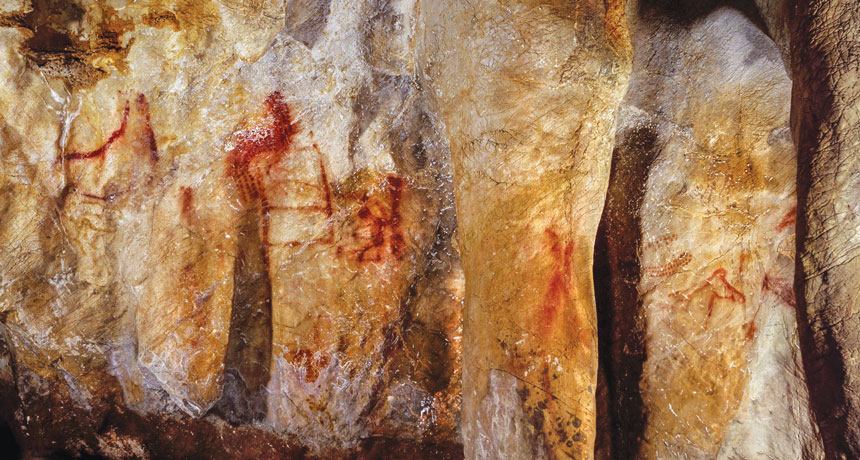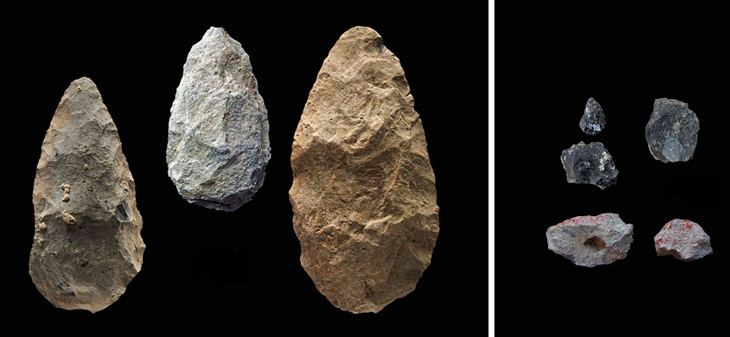Human smarts got a surprisingly early start
Our ancestors’ ingenuity enabled long-distance treks and artistic endeavors

NEANDERTAL ART Red horizontal and vertical lines painted on a Spanish cave’s walls may date to at least 64,800 years ago. Homo sapiens had not yet reached Europe, so researchers propose Neandertals created the art.
© P. SAURA
Archaeological discoveries reported this year broadened the scope of what scientists know about Stone Age ingenuity. These finds move the roots of innovative behavior ever closer to the origins of the human genus, Homo.
Example No. 1 came from Kenya’s Olorgesailie Basin, where fickle rainfall apparently led to a wave of ancient tool and trading advances (SN: 4/14/18, p. 8). Frequent climate swings in East Africa probably stimulated the creation of new types of stone tools and the formation of trading networks by about 320,000 years ago, said a team led by paleoanthropologist Rick Potts of the Smithsonian Institution in Washington, D.C. Soil analyses point to shifts from dry to rainy conditions every few years or decades at Olorgesailie around that time, the researchers noted in Science in March.
Potts has argued since the 1990s that humans and our direct ancestors evolved to deal with frequent environmental shifts, making human evolution a story of “survival of the versatile.” That’s still a controversial idea, but the Olorgesailie finds support Potts’ scenario.

No Homo fossils have been found at the Kenyan location, leaving the toolmakers’ evolutionary ID unknown. But the timing is right for the Olorgesailie folk to have been Homo sapiens (SN: 12/23/17, p. 24).
If they were, Olorgesailie groups heralded later Stone Age artistic innovations by humans elsewhere. A crosshatched design on a rock found in South Africa was made by humans around 73,000 years ago, making it the oldest known drawing, another team reported this year (SN: 10/13/18, p. 6).
Meanwhile, in a cave on the Southeast Asian island of Borneo, researchers uncovered the oldest known painted figure, depicting a horned animal, which dates to at least 40,000 years ago (SN: 12/8/18, p. 8). Even Neandertals got in on the act, creating abstract rock art in Spanish caves at least 64,800 years ago, one study suggests (SN: 3/17/18, p. 6). Once portrayed as humans’ brutish cousins, Neandertal artistry implies that the hominids were humans’ mental equals.
Another report this year suggested that Stone Age ingenuity took a surprising turn long before those early artists or the Olorgesailie crowd made their marks. Archaeologists discovered the oldest signs of a Homo presence way outside of Africa, nearly 7,000 kilometers away in China. Humanlike populations, perhaps Homo erectus, reached central China about 2.1 million years ago, Zhaoyu Zhu of the Chinese Academy of Sciences in Guangzhou and colleagues reported in Nature in July (SN: 8/4/18, p. 7). That’s about 250,000 years before what was previously the oldest outside-of-Africa evidence, in western Asia.
Even if early Homo populations simply followed migrating herds of prey across Asia without planning to travel far, those intrepid hunters would have had to adjust on the fly to novel habitats and climates along the way. That neat trick foreshadowed Olorgesailie people’s innovative aptitude by more than 1.7 million years.
When naming the earliest species in the human genus, scientists have emphasized hands designed for toolmaking (H. habilis) and upright gaits (H. erectus). Based on the latest archaeological findings, a better title for those inventive pioneers may be Homo versatilis.








